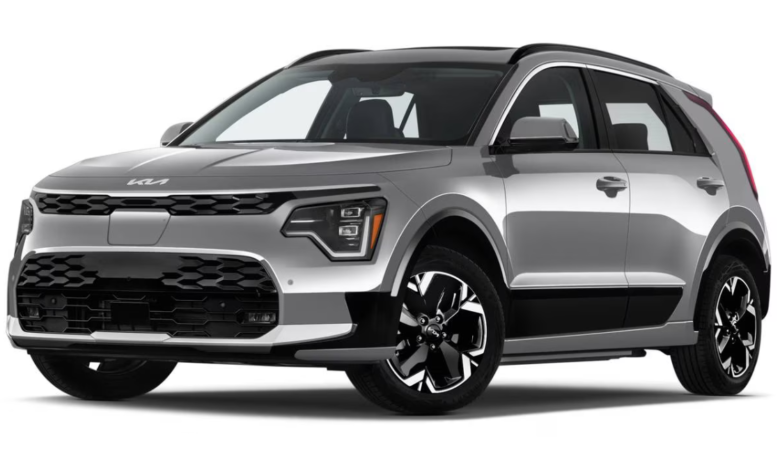
As the electrified Niro family enters its second generation, the Kia Niro EV will receive a comprehensive facelift in 2023 despite being just three years old. It’s part of a complete redesign of the Niro range, including plug-in hybrid and hybrid versions that we assess separately. The redesigned, much more fashionable Niro EV, at 174 inches long, is still a compact two-row crossover that some may mistake for a tall hatchback or wagon. Customers looking for an efficient vehicle with a considerable range for weekend travel while still manageable in congested cities are the target market for this model.
The Niro EV will retain its front-drive powertrain in 2023 (an all-wheel drive variant is unavailable). Still, it will also have new sheet metal, an updated interior with a more futuristic design, and upgraded technologies. It comes in two flavours: the luxurious Wave and the well-equipped Wind. Beginning with the larger and more potent Kia EV6, the Wave name scheme drew inspiration from nature. The new sheet metal hides a similar powertrain. However, it provides a more excellent range (253 miles as opposed to the previous 239), quicker charging times (about 25% using a DC fast charger), and marginally better energy efficiency.
Performance and luxury are not attributes that the Niro EV or its most likely rivals, the Chevrolet Bolt EUV, Nissan’s Leaf SV Plus, and rear-drive Volkswagen ID.4 variants, are renowned for. They are middle-of-the-road vehicles with cargo capacity meant for a pleasant ride, obedient handling, and respectable usefulness. The new Niro EV checks all the boxes while topping the group in overall range and behind the much bigger ID.4 by just a little margin in total load capacity (63.7 cubic feet compared to the VW’s 64.2 cubes).
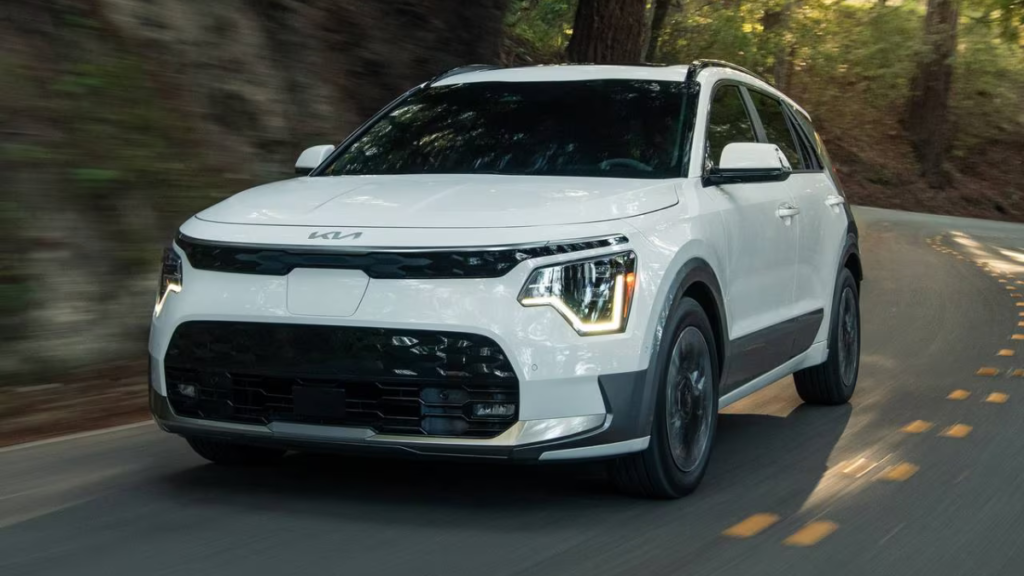
The front-drive Niro EV’s 201 horsepower and bland handling characteristics are similar to the rear-drive ID.4 and Leaf’s somewhat stodgy performance. Though no one can brag about their zero-to-60 acceleration time, the lighter and faster Bolt EUV is ahead of the Niro EV with its 7.8 seconds, tying with the ID.4 for second place in the class. There are two Niro EV trim levels with the same drivetrain. The main difference between the $40,745 Wind trim and the $45,745 Wave trim is that the Wave has a more opulent interior and amenities.
Though it wouldn’t be worthy of an honour roll at any Museum of Modern Art, the 2023 Niro EV demonstrates Kia’s intention to depart from boring design. Many contrasting colours and forms are used, with a substantial vertical “aero blade” panel behind the rear doors and very few straight lines, either inside or outside. The EV6 significantly influenced the Niro’s interior, which features a sleek, modern dashboard and a variety of strangely harmonious geometric forms. This car has a more elegant look and plenty of space for drivers and passengers to walk around, even though the interior is not particularly opulent.
The base package for the Niro EV includes an extensive array of high-tech safety and driver assistance features, some of which are optional for the hybrid Niros. In addition to numerous alerts and lane-keeping aids, these technologies include full-range, navigation-based cruise control. Furthermore, remote competent parking assistance and automated lane changes are available with the Wave trim. While the 2023 Niro EV is an improvement over its predecessor in every aspect, it is no longer eligible for federal tax incentives, and its high starting price may make it less competitive with the less expensive Bolt EUV.
What’s New
- The electric Niro is available in addition to the independently evaluated conventional Niro and hybrid models.
- Extended range of 14 miles
- A slight improvement in fuel economy
- Elegant and contemporary exterior and interior design
- Larger loading capacity. More legroom in the back
- An expanded list of standard driver assistance and safety features
- The old “Alpha” and base “S” decorative designations have been removed.
- New “natural” names were given to the remaining motifs: Wave and Wind
- It loses eligibility for federal tax credits due to recent “Made in North America” standards.
Pros & Cons
Pros
- Roomier than predecessor
- Segment best driving range
- Eye-pleasing design
Cons
- Lukewarm performance
- More costly than rival brands
- Ineligibility for federal tax credits to lessen the hardship of rising prices
Performance:Kia Niro EV
Despite a visual and interior overhaul, the 2023 Niro EV’s 201-horsepower front-drive engine and 64.8-kWh battery remain the same. It has a meagre 188 pound-feet of torque, although these numbers are far more than the hybrid Niros.
According to Kia, it will reach 60 mph in 7.8 seconds, and it can easily merge onto a highway and climb hills. However, it is more suited for relaxing country driving and metropolitan commuting than wild outings. The Bolt EUV is the quickest among the compact electric crossovers, reaching 60 mph in 6.7 to 7 seconds, according to many enthusiast magazines.
Kia engineers designed the Niro as a family vehicle for Sunday drives, shopping outings, and daily commuting. It is not intended for off-road use, and even with the “Sport” driving mode (Normal and Eco are the other options), cruising about on winding rural roads is not very enjoyable. However, neither are its main rivals. But as a daily vehicle, the Niro EV provides smooth driving and a cosy ride. Kia believes customers who want more will be satisfied with the bigger EV6.
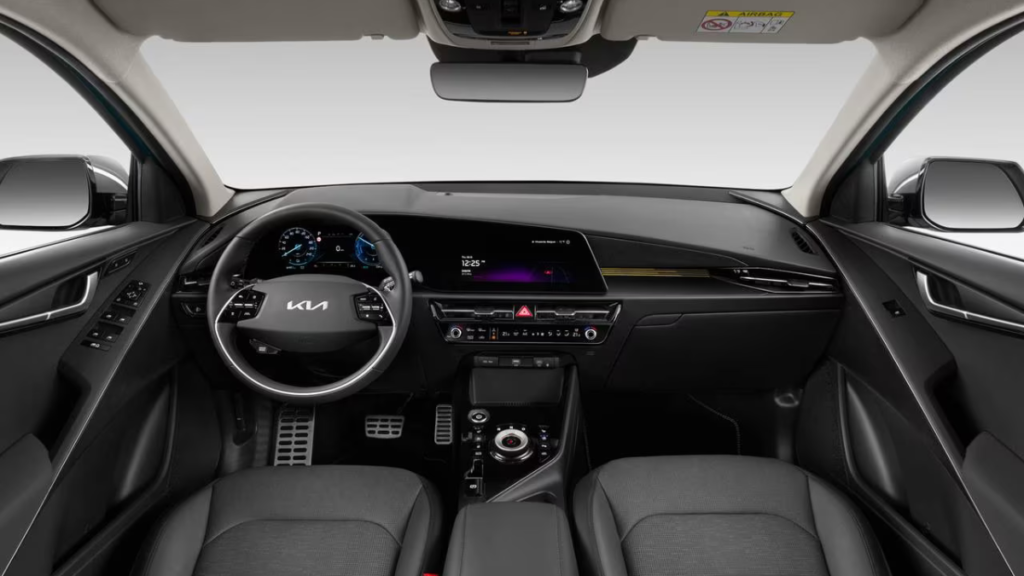
Power Consumption, Charging, and Range:
The 2023 Niro EV has an efficiency rating of 113 miles per gallon, up from 112 MPGe in 2022, with a 29 kWh power consumption per 100 miles. With an EPA rating of 115 MPGe, the Bolt EUV ties at 29 kWh per 100 miles. Every 100 miles, the ID.4 (107 MPGe) and Leaf SV Plus (109 MPGe) use 31 kWh of energy. All EVs use 34.6 kWh on average for every 100 kilometres.
Compared to the Bolt EV’s 247 miles, the Leaf SV’s 212 miles, and the ID’s 209 miles, the Niro EV has an EPA-estimated range of 253 miles between charges. Four trims: Standard and S. A heat pump and heated rear seats are part of the $1,300 “Preserve” package option, which also helps extend the vehicle’s cold weather range by using less battery power for the heating system.
The Niro can recharge an empty battery to 80% capacity in 45 minutes using DC fast charging, which is 15 minutes quicker than the Niro 2022. It takes five minutes less for the ID.4 and over an hour for the Leaf and Bolt. An 11-kW Level 2 (240 volts) home charger for the Niro EV can recharge a completely dead battery in around 7 hours. While the ID.4 and Bolt EUV are rated at 7.5 hours, the Leaf has a maximum take time of 11 hours.
Driver assistance and safety:
Since none of the major testing organizations have crash-tested the 2023 Niro EV, we deduct points from it. You should anticipate comparable or superior outcomes when the new model is evaluated since the 2022 model earned a five-star safety rating from the Australian New Car Assessment Program (ANCAP) and the National Highway Traffic Safety Administration (NHTSA). As soon as the data is received, we’ll update our ranking.
High-tech safety and driver assistance features come standard on the Niro EV. These include full-range navigation-based cruise control, an in-cabin system that checks how alert the driver is, blind spot warning, lane departure warning and lane keeping assist, lane following assist, blind spot monitor, rear cross-traffic alert, front and rear collision mitigation, and rear parking sensors.
Kia’s Highway Driving Aid 2 (HDA 2) package adds automatic lane shifting to the driver’s aid features when the turn signal is activated. The Wave trim also has front parking sensors, rear parking accident avoidance, and remote intelligent parking assistance.
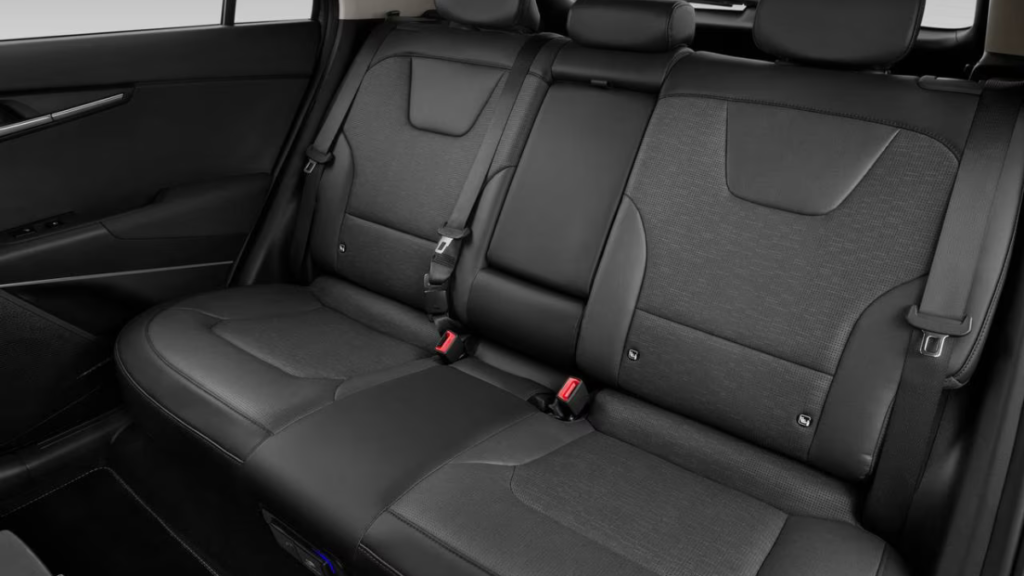
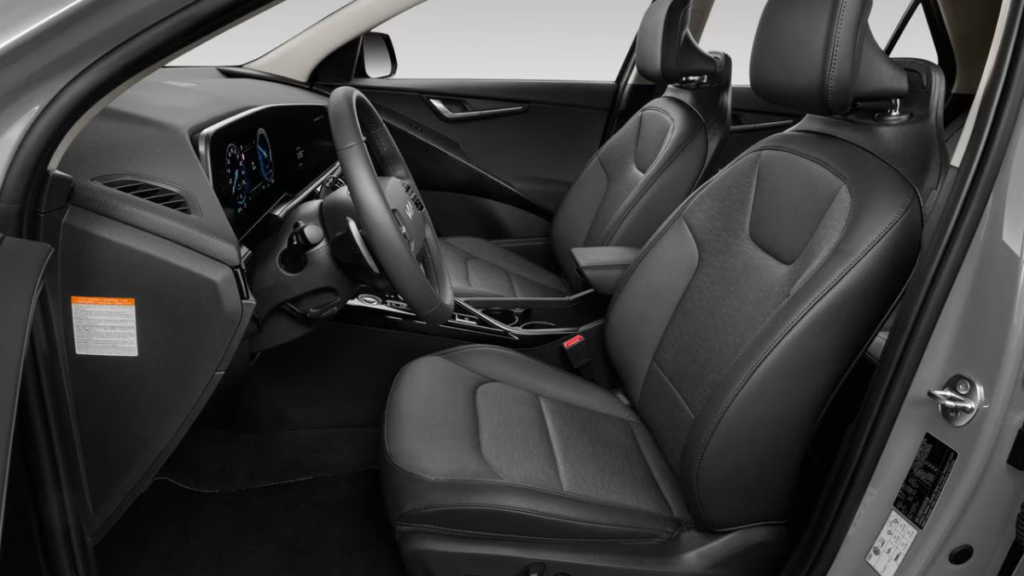
Coziness & Space:Kia Niro EV
The body length of the 2023 Niro was increased by over 2.5 inches to 174 inches in total. Most of the additional space was used to expand the Niro’s load capacity and back legroom, although it still falls short of its hybrid brothers. Compared to the 2022 Niro EV, there is almost an inch of extra back legroom, measuring 36.9 inches. This allows second-row passengers to stretch out a little, but not quite as much as in the class-leading Bolt EUV (39.1 inches) or the ID.4 (37.6 inches), nor does it come close to the enormous 39.8 in the hybrid and PHEV Niros.
The Niro is second only to the Leaf in front headroom and does have more excellent back headroom than any of its rivals. Compared to the 2022 model, a little increase in wheelbase somewhat enhances ride comfort. The front, thin-profile seats provide plenty of legroom, sufficient adjustability, and comfort and support. The front passenger seat can be raised or lowered to provide simple access to the controls and storage compartments, and it is easy to get in and out of the car without running over the top of the door frame.
The centre armrest pulldown is well positioned in the tight middle position, while the second-row bench seat might benefit from more cushioning. However, the rear doors open wide enough to allow for simple entry and exit, and plenty of headroom is in the back. The temperature control system vents are separate for the rear seats.
Infotainment: Kia Niro EV
Of the three Niros, the EV is the flagship model and comes with the most standard features, such as two 10.25-inch digital displays (one for entertainment and the other for driver information).
While the displays control many of the vehicle’s functions, there are physical knobs and buttons for the music and temperature systems, driving modes, seat warmers, and, if available, coolers. Regenerative braking may be adjusted at many levels, including a one-pedal way, using the “shifter” paddles on the steering wheel. However, it is annoying that the brake system must be reset each time the ignition is turned off.
The infotainment touchscreen’s well-navigated menus and comprehensible iconography make it simple. Premium Harman Kardon audio and navigation are included in both trim levels. Although Wi-Fi isn’t accessible, wired Apple CarPlay and Android Auto are also included. The centre console has two USB-A and one USB-C connector, while the rear seats have two USB-A inputs for second-row passengers conveniently located on the backs.
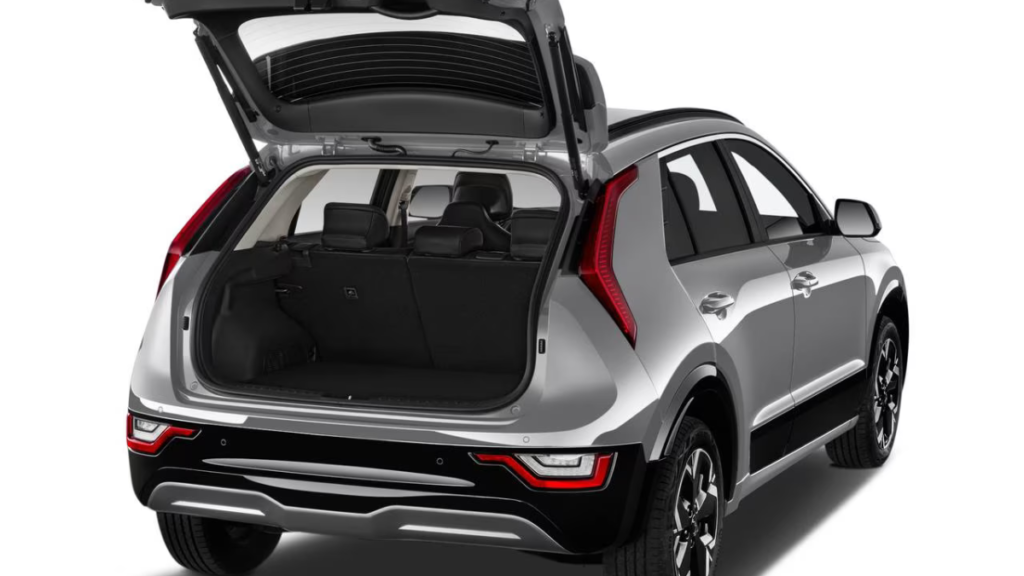
Storage and cargo space:
Kia understands that load space is the most critical factor in crossover utility, even if they are tall wagons. The Niro EV offers the same roomy load capacity as its gas-only and gas-electric stablemates since it is built on a platform that accommodates standard, hybrid, or all-electric powertrains. No interior space had to be sacrificed to make way for the batteries.
When the seatbacks are folded down, there are 22.8 cubic feet of room behind the rear seats and 63.7 cubic feet behind the seatbacks. With 30.2 cubic feet behind the back seats and 64.2 cubic feet when the seatbacks are folded, the VW ID.4, which is half a foot larger and three inches higher than the Niro EV, is the class leader—but only just.
With a lockable glove box, covered and open centre console cubbies, door and seatback pockets, and a fold-down armrest with cup holders for the 60/40 split rear seat, there is plenty of storage space within the cabin. Under the hood is a tiny covered “frunk,” the front trunk. Only the ID.4 is rated for towing among rivals, including the Niro EV, although it does have flush-mounted roof rails and can tow up to 220 pounds when rooftop carriers are attached correctly.
Design: Kia Niro EV
The 2023 Niro’s facelift provides the compact crossover with a remarkably contemporary appearance, in contrast to the previous model’s mind-numbing blandness. A pouty front fascia, a few straight lines, plenty of contrasting colour trim, and boomerang taillights add flair. The vertical “aero blade” panel behind the rear doors, which improves aerodynamics and looks great, adds character. The paint quality is superb, the outside panel gaps are narrow, crisp, and even, the panels fit well, and the standard 17-inch wheels adequately fill the wheel wells.
The EV6 inspired Kia designers when creating the interior layout and design of the Niro. It is very futuristic with its sweeping, glass-fronted digital screen array and various curves and geometric forms that shouldn’t fit together but do. Everything is environmentally friendly with vegan “leather,” fabric fragments spun from eucalyptus leaves, and headliner material derived from recycled wallpaper. In this category, this interior may have the most excellent aesthetics.
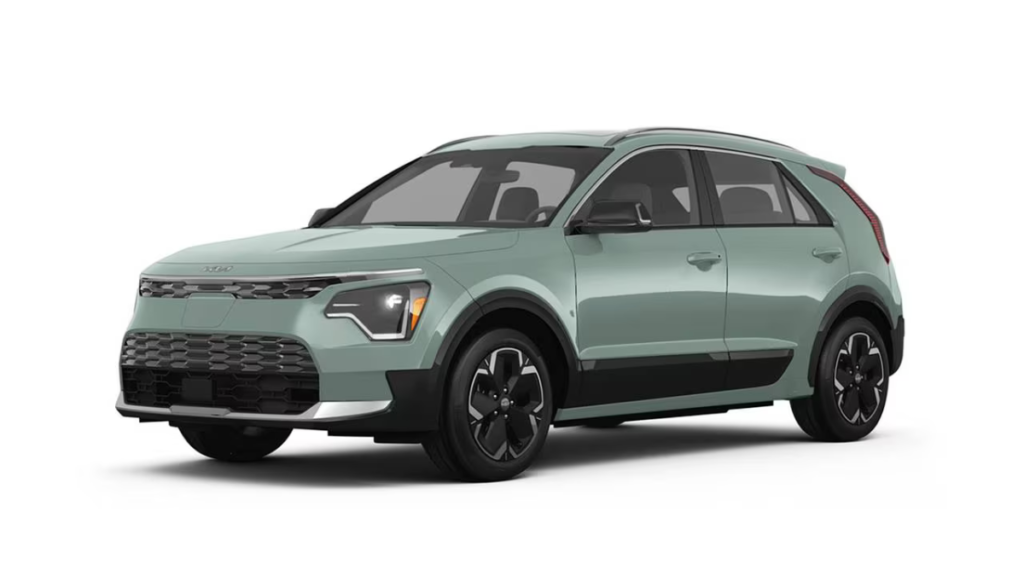
Is the Kia Niro EV from 2023 worth it?
After launching its sleeker-looking second generation, the Niro EV is expected to win more awards for features and appearance than it did in its first year. However, it has several deserving rivals; the Nissan Leaf SV is the only one that outperforms in every area.
It costs hundreds of dollars more than its most likely competitors, but it does provide a more excellent range. In many buyers’ value calculations, the price difference could not be enough, mainly because the Leaf and the Chevy Bolt EUV, which will become available after December 31, 2022, are eligible for federal tax credits that can reduce their already meagre costs by up to $7,500.
Since the two Niro EV levels share identical powertrains and performance characteristics, the standard Wind ($40,745) is the superior option—that is, unless extras like a sunroof, power takeoff, and cooled front seats justify the $5,000 more for the Wave trim.
The more giant and perhaps more stylish Kia EV6 Light, which has a 232-mile range and more standard equipment than the Niro EV but less power, begins at $48,500, so it’s unlikely to compete with Niro EV buyers.
How Much Does the 2023 Kia Niro EV Insurance Cost?
As with most of its competitors, insurance for the Kia Niro EV should be expensive. The average yearly premium for a 30-year-old female driver with a spotless record is $2,135. However, this figure applies to all 50 states. As the Niro EV is brand new for 2023, our study indicates that it should be comparable to other EVs of the same kind. Owners of a VW ID.4 may have to pay up to $2,550 annually, compared to $2,100 for the Nissan Leaf SV Plus and $2,100 for the Chevy Bolt EUV.
Kia Niro EV Generations
Second Generation
2023 to Present
All three Niro powertrain options—standard, plug-in hybrid, and full electric—will be redesigned and available in 2023. Infotainment and driver information panels are housed behind a glass-fronted panel placed horizontally and curves. The 2019 HabaNiro concept had an impact on the outside style. All the lights are LED, including the practically square headlights now located significantly lower on the front end and the boomerang-shaped taillights. A rear quarter panel is designed to resemble an “aero blade” in contrasting colours.
The 64.8-kWh battery pack of the EV is positioned under the floor to provide a low centre of gravity. There are 293 pound-feet of instantly accessible torque and 201 horsepower in the EV drivetrain. According to Kia, the EV will reach sixty miles per hour in 7.6 seconds. With a fully charged battery, the EV can go up to 253 miles, 14 miles further than its predecessor.
First Generation
2017 to 2022
Beginning with the 2017 model year, the Kia Niro was released. 2018 saw the release of a plug-in model, while 2019 saw the release of a completely electric vehicle. The most notable minor change for 2020 and 2021 was adding an adaptive cruise control system based on navigation.
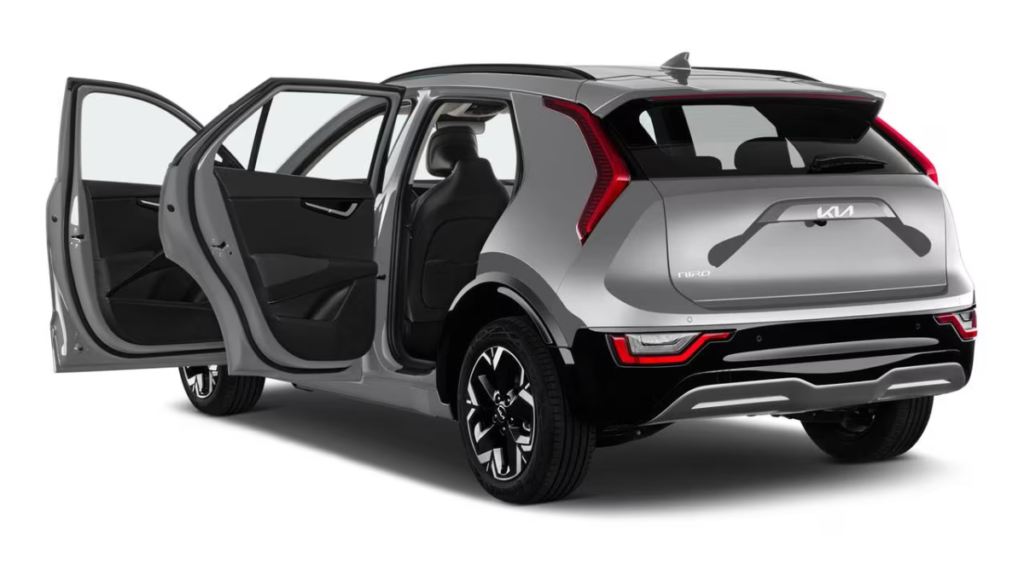
Verdict
The 2023 Kia Niro EV has had a makeover that provides a whole new interior, an SUV-like appearance, and a little increase in range, keeping it at the top of the small electric crossover market. In addition, it provides cutting-edge safety and driver-aid technologies, along with a vast array of standard amenities. The Niro EV delivers economy and comfort and has a more extensive interior than most competitors. However, it has the same stodgy powerplant, so anyone looking for a sportier ride with snappy pedal reactions and handling should go elsewhere. In addition, the Niro EV costs more than its rivals, which may offset its significant advantages.




